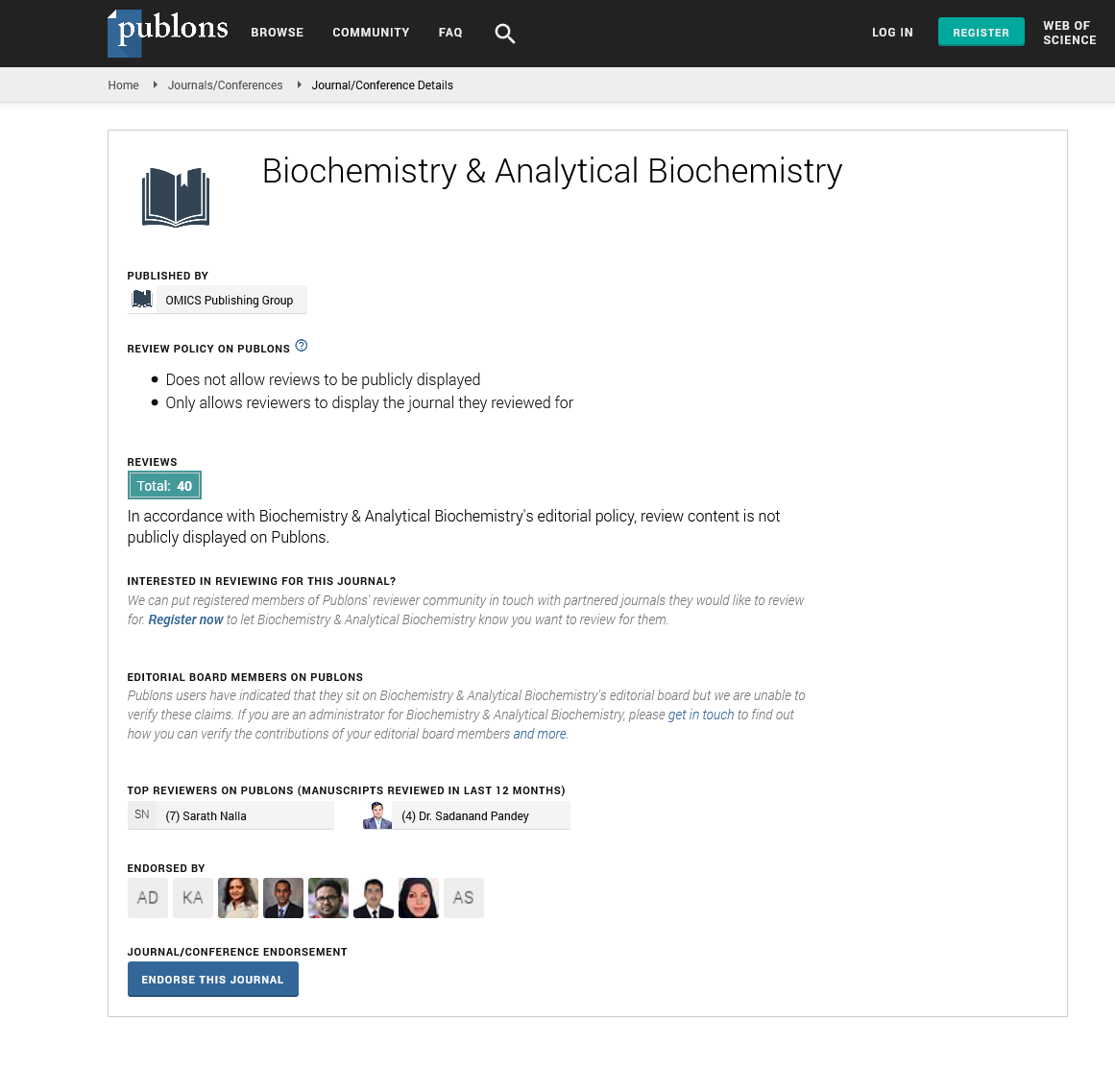Indexed In
- Open J Gate
- Genamics JournalSeek
- ResearchBible
- RefSeek
- Directory of Research Journal Indexing (DRJI)
- Hamdard University
- EBSCO A-Z
- OCLC- WorldCat
- Scholarsteer
- Publons
- MIAR
- Euro Pub
- Google Scholar
Useful Links
Share This Page
Journal Flyer

Open Access Journals
- Agri and Aquaculture
- Biochemistry
- Bioinformatics & Systems Biology
- Business & Management
- Chemistry
- Clinical Sciences
- Engineering
- Food & Nutrition
- General Science
- Genetics & Molecular Biology
- Immunology & Microbiology
- Medical Sciences
- Neuroscience & Psychology
- Nursing & Health Care
- Pharmaceutical Sciences
Opinion Article - (2024) Volume 13, Issue 4
Innovations in Biochemical Profiling: New Tools for Targeted Biomarker Discovery
Ahmed Sayed*Received: 27-Nov-2024, Manuscript No. BABCR-24-28134; Editor assigned: 29-Nov-2024, Pre QC No. BABCR-24-28134 (PQ); Reviewed: 13-Dec-2024, QC No. BABCR-24-28134; Revised: 20-Dec-2024, Manuscript No. BABCR-24-28134 (R); Published: 27-Dec-2024, DOI: 10.35248/2161-1009.24.13.565
Description
Innovations in biochemical profiling are leading a new era of biomarker discovery, providing researchers and clinicians with powerful tools to better understand disease mechanisms, improve early diagnosis, and develop personalized treatment strategies. Biomarkers measurable indicators of biological processes, conditions, or diseases play a key role in clinical practice, helping to detect diseases at an early stage, examine disease progression, and predict therapeutic outcomes. Advances in biochemical profiling technologies have greatly expanded the ability to identify and characterize biomarkers with greater sensitivity, specificity, and throughput, enabling the discovery of novel biomarkers for a wide range of diseases, including cancer, cardiovascular diseases, and neurodegenerative disorders.
One of the most significant innovations in biochemical profiling is the development of high-throughput technologies that allow for the simultaneous analysis of thousands of molecules across various biological samples. These tools enable the rapid and comprehensive characterization of complex biomolecular signatures, facilitating the discovery of novel biomarkers that were previously difficult to detect. High-Throughput Screening (HTS) platforms, for example, allow for the testing of large numbers of potential biomarkers in a short period of time, using automated processes that can evaluate thousands of compounds, proteins, or metabolites. The ability to quickly and efficiently identify potential biomarkers has accelerated the rate biomarker discovery, particularly in cancer research, where the identification of early-stage biomarkers is important for improving patient outcomes.
Mass Spectrometry (MS) has become a basis technology in biochemical profiling, enabling the identification and quantification of proteins, metabolites, and other biomolecules with exceptional sensitivity and accuracy. MS-based platforms, such as Liquid Chromatography-Mass Spectrometry (LC-MS), have revolutionized proteomics and metabolomics by providing detailed profiles of protein expression, Post-Translational Modifications (PTMs), and metabolic alterations. This approach is particularly useful for biomarker discovery in diseases such as cancer, where changes in protein expression and metabolism play a central role in tumorigenesis and disease progression. With the advent of high-resolution mass spectrometers and advanced data analysis techniques, MS has become an indispensable tool for identifying disease-specific biomarkers, enabling the detection of low-abundance proteins and metabolites that were previously undetectable.
In addition to MS, another powerful technique in biochemical profiling is Next-Generation Sequencing (NGS), which has revolutionized genomics and transcriptomics. NGS allows for the high-throughput sequencing of DNA and RNA, providing insights into genetic mutations, gene expression profiles, and alterations in transcriptional regulation. This technology has enabled the discovery of genetic biomarkers associated with inherited diseases, cancer, and other conditions. For example, NGS has been used to identify mutations in oncogenes and tumor suppressor genes, providing valuable information for cancer diagnosis, prognosis, and treatment selection. The combination of NGS with other omics technologies, such as proteomics and metabolomics, enhances the power of biomarker discovery by integrating genetic, transcriptomic, and proteomic data to provide a more comprehensive view of disease mechanisms.
Another major innovation in biochemical profiling is the development of microfluidic platforms, which allow for the manipulation and analysis of small volumes of biological samples. Microfluidic devices, often referred to as "lab-on-a-chip" technologies, can integrate multiple biochemical assays into a single device, enabling rapid, cost-effective, and high-throughput analysis of biomarkers. These platforms are particularly useful for point-of-care diagnostics, where quick and accurate results are essential for timely clinical decision-making. For example, microfluidic devices have been used to detect Circulating Tumor Cells (CTCs) in blood samples, providing a non-invasive method for monitoring cancer progression and therapeutic response. Additionally, microfluidics can be used to analyze biomarkers in complex biological fluids, such as plasma or cerebrospinal fluid, for diseases like Alzheimer’s and Parkinson’s, where early detection is critical for improving patient outcomes.
The use of nanotechnology in biochemical profiling has also opened new avenues for targeted biomarker discovery. Nanomaterials, such as gold nanoparticles, quantum dots, and carbon nanotubes, offer unique properties that can enhance the sensitivity and specificity of biomarker detection. Nanoparticles can be functionalized with specific ligands, such as antibodies or aptamers, to selectively bind target biomarkers, enabling the detection of low-abundance molecules in complex samples.
Citation: Sayed A (2024). Innovations in Biochemical Profiling: New Tools for Biomarker Discovery. Biochem Anal Biochem. 13:565.
Copyright: © 2024 Sayed A. This is an open access article distributed under the terms of the Creative Commons Attribution License, which permits unrestricted use, distribution, and reproduction in any medium, provided the original author and source are credited.

